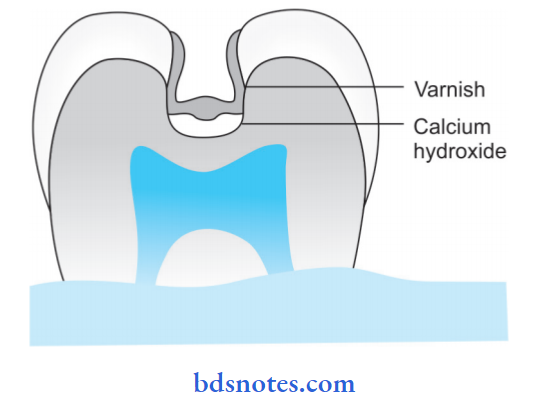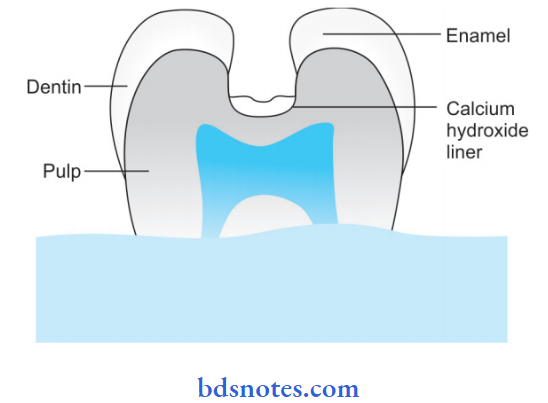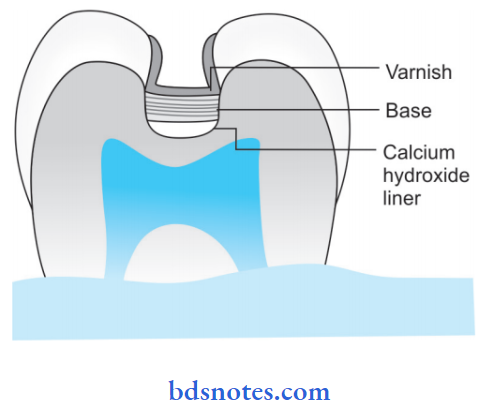Base, Liner And Varnish
Question 1. Write a short note on cavity liners and varnishes.
Or
Write a short note on cavity varnishes.
Or
Write a short note on cavity varnish and liner.
Or
Write a short note on cavity varnish
Answer:
Cavity varnish is a solution of one or more resins in a volatile solvent which when applied onto the cavity walls, evaporates leaving a thin resin film that serves as a barrier between the restoration and dentinal tubules.
Read And Learn More: Dental Materials Question And Answers
Compositions of Cavity varnish:
- Natural gum such as copal, rosin, or synthetic resin dissolved in an organic solvent like alcohol, acetone, or ether.
- Medicinal agents such as chlorobutanol, thymol and eugenol may be added. Some varnishes also contain fluorides

Applications of Cavity varnish:
- It reduces microleakage around the margins of newly amalgamed restorations.
- It reduces the passage of irritants into the dentinal tubules from the overlying restorations or base.
- It also prevents the penetration of corrosion products into the dentinal tubules in case of amalgam restorations, thus minimizing the tooth discoloration.
- Varnish may be used on the surface of metallic restoration as a temporary protection in case of galvanic shock.
- Varnish may be used as a surface coating over certain restorations to protect them from dehydration or contact with oral fluids, for example
- Glass Ionomer Cement (GIC) and silicate restorations.
Precautions of Cavity varnish:
- Varnish should be tightly capped immediately after use to prevent loss of solvent by evaporation.
- It should be applied in thin consistency.
- Excess varnish should not be left on the margins of restorations as it prevents proper finishing of the margins of restorations
Placement of Cavity varnish:
- Apply varnish by small cotton pledget or by applicator tip.
- The solvent gets evaporated and leaves a thin layer of resin behind with porosities.
- Now a second layer is applied to get a uniform thin layer of varnish.
Disadvantages of Cavity varnish:
- Varnish should not be used under composites as it interferes polymerization process of composites.
- Under the GIC and polycarbonate cement, it interferes with chemical bonding and fluoride release.
Question 2. Write a short note on cavity liners.
Or
Describe briefly cavity liners.
Or
Answer briefly on cavity liners.
Answer:
Cavity liners are cement coatings of minimal thickness that are applied to the prepared cavity when the remaining dentin thickness is adequate.
Purpose of Cavity Liners:
- They serve as a physical barrier to ingress bacteria or bacterial products.
- They provide therapeutic effects, i.e. antibacterial, anticarcinogenic, and pupal anodyne effects.
- They provide a barrier for the protection of pulp from residual reactants which diffuse out of the restoration.
- They prevent oral fluids which can penetrate leaky restoration from reaching pulp via dentin.
- When they are used under metallic restorations they contribute to some electrical or thermal insulation.
Classification of Cavity Liners:
- Thin film liners (1 to 50 µm)
- Solution liners (Varnish; 2 to 5 µm)
- Suspension liners [Zinc oxide (Type IV)/calcium hydroxide; 20 to 25 µm]
- Thick liners (200 to 1000 µm)
- Type III GIC.
Supplied Cavity Liners:
- The solution is in bottles.
- Powder and liquid.
- Single light-cured paste.
Composition of Cavity Liners:
Suspension of calcium hydroxide in an organic liquid such as methyl ethyl ketone or ethyl alcohol. Acrylic polymer heads or barium sulfate, monoflorophosphate.

Properties of Cavity Liners:
- Liner neither possesses mechanical strength nor provides any significant thermal insulation.
- The calcium hydroxide liners are soluble and should not be applied at the margins of restorations.
Manipulation of Cavity Liners:
Cavity liners are fluid in consistency and can be easily flawed or painted over dentinal surfaces. The solvent evaporates to leave a thin film residue that protects the pulp.
Question 3. Write a short note on cavity bases and liners.
Or
Write a short note on cavity bases.
Answer:
A base or cavity base is a layer of cement placed beneath a permanent restoration to encourage recovery of the injured pulp and to protect it against numerous types of insults to which it may be subjected.
Types of insults depend on particular restorative material. It can be thermal or chemical or galvanic. The base serves as a replacement or substitute for protective dentin which is destroyed by dental caries or cavity preparation.
Classification of Bases and Liners.
- Low-strength base
- Zinc oxide eugenol (ZOE) and calcium hydroxide
- Used under temporary or interim restorations
- Calcium hydroxide is used as sub-base
- High-strength bases
- GIC, reinforced ZOE, zinc phosphate, Zinc polycarboxylate
- Used under direct and indirect metallic restorations.
Indications of Bases and Liners:
- For protecting the pulp against thermal injury, galvanic shock, and chemical irritation.
- To withstand forces of condensation of restorative material and act as a shock absorber.
- To substitute dentin in deep cavities
- To serve as an intermediate bonding material between the tooth and composite restoration
- To prevent ingress of bacteria and their noxious products in dentinal tubules via microleakage.
Clinical Considerations of Bases and Liners:
- The base should be 0.5 to 0.75 mm in thickness. If the base is very thick, it can compromise the bulk of restoration and increase the potential for fracture of restoration.
- Sound tooth structure should never be removed to provide space for placing the base.
- The base should always be applied on the internal wall of the cavity in preparation for preventing its dissolution by saliva.
Question 4. Write a short note on agents for pulp protection.
Answer:
Agents for pulp protection are:
- Varnish
- Sealer
- Liner
- Base.

Varnish: Varnish or Cavity varnish is a solution of one or more resins in a volatile solvent which when applied onto the cavity walls, evaporates leaving a thin resin film that serves as a barrier between the restoration and dentinal tubules.
Sealer: It is used to seal dentinal tubules and to treat dentin hypersensitivity. An adhesive sealer is commonly used under indirect restorations. For the application of sealer, a cotton tip applicator is used to apply sealer on all areas of exposed dentin.
Liner: Liner or Cavity liners are cement coatings of minimal thickness that are applied to the prepared cavity when the remaining dentin thickness is adequate.
Base: Base or cavity base is a layer of cement placed beneath a permanent restoration to encourage recovery of the injured pulp and to protect it against numerous types of insults to which it may be subjected.
Question 5. Write a short note on fluorides.
Answer:
Fluorides are the agents to improve the resistance of teeth to dental caries. Fluoride agents are the most effective and easy method of increasing the resistance of the tooth to dental decay
Systemic Fluoridation:
Water fluoridation or systemic fluoride in the form of drops or tablets produces a dramatic reduction in caries levels.
Topically Applied Fluoride:
- Effect:
- The topical fluoride converts some of the surface hydroxyapatite into acid-resistant fluorapatite.
- It can be in the form of mouthwashes or dentifrices. These are effective due to the frequency of use.
- The dentist can also apply them as fluoride varnishes or pastes. These are less effective.
Other agents used include the following:
- Fluoride mouthwashes: Flavored solutions containing either 0.05 or 0.2 % sodium fluoride along with antiplaque agents.
- Use: Undiluted rinse is swished intraorally either daily (0.05%) or weekly (0.2%).
- Fluoride tablets/drops: Flavored tablets or solutions containing either 0.5 mg or 1.0 mg of sodium fluoride.
- Use: The tablets or drops are used on an everyday basis. It is especially indicated in regions where the community supply contains less than 0.3 ppm of fluoride.
- Fluoride gels: Gels of adulated phosphate fluoride (APF) or 0.4% stannous fluoride with hydroxyethyl cellulose thickening agents.
- Use: The gel is applied to the entire dentition at one time by using two flexible trays, which contain a close-fitting paper of foam absorbent liners soaked in the gel. It should be applied for 4 or 5 minutes. Rinsing should be avoided for 30 minutes.
- Fluoride varnishes: Fluoride varnishes are used to prevent tooth decay on smooth surfaces. Fluoride varnishes are painted onto the teeth with a special tiny brush. Teeth are cleaned with tooth- a brush fist and then dried with a gauge and after this varnish should be applied.

Leave a Reply